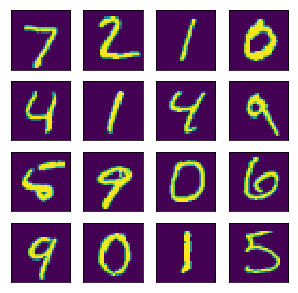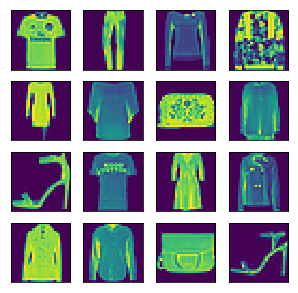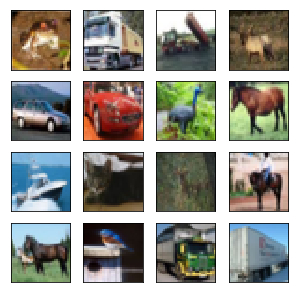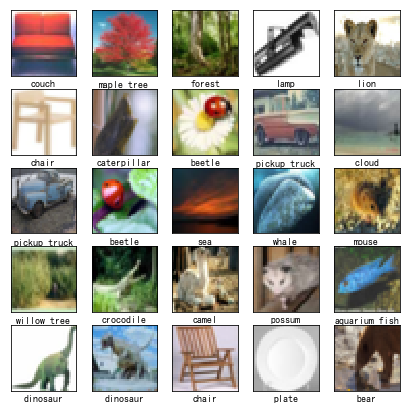深度學習常用資料集 API
基準資料集
深度學習中經常會使用一些基準資料集進行一些測試。其中 MNIST, Cifar 10, cifar100, Fashion-MNIST 資料集常常被人們拿來當作練手的資料集。為了方便,諸如 Keras、MXNet、Tensorflow 都封裝了自己的基礎資料集,如 MNIST、cifar 等。如果我們要在不同平臺使用這些資料集,還需要了解那些框架是如何組織這些資料集的,需要花費一些不必要的時間學習它們的 API。為此,我們為何不建立屬於自己的資料集呢?下面我僅僅使用了 Numpy 來實現資料集 MNIST、Fashion MNIST
Cifa 10、Cifar 100 的操作,並封裝為 HDF5,這樣該資料集的可擴充套件性就會大大的增強,並且還可以被其他的程式語言 (如 Matlab) 來獲取和使用。下面主要介紹如何通過建立的 API 來實現資料集的封裝。
環境搭建
我使用了 Anaconda3 這個十分好用的包管理工具, 來減少管理和安裝一些必須的包。下面我們載入該 API 必備的包:
import struct # 處理二進位制檔案 import numpy as np # 對矩陣運算很友好 import gzip, tarfile # 對壓縮檔案進行處理 import os # 管理本地檔案 import pickle # 序列化和反序列化 import time # 記時
我是在 Jupyter Notebook 互動環境中執行程式碼的。
Bunch 結構
為了更好的使用該 API, 我利用了 Bunch 結構。在 Python 中,我們可以定義 Bunch Pattern, 字面意思大概是指鏈式的束式結構。主要用於儲存鬆散的資料結構。
它能讓我們以命令列引數的形式建立相關物件,並設定任何屬性。下面我們來看看 Bunch 的魅力!Bunch 的定義利用了 dict 的特性。
class Bunch(dict): def __init__(self, *args, **kwds): super().__init__(*args, **kwds) self.__dict__ = self
下面我們構建一個 Bunch 的例項 Tom, 它代表一個住在北京的 54 歲的人。
Tom = Bunch(age="54", address="Beijing")我們可以檢視 Tom 的一些資訊:
print('Tom 的年齡是 {},他住在 {}.'.format(Tom.age, Tom.address))Tom 的年齡是 54,他住在 Beijing.我們還可以直接對 Tom 增加屬性,比如:
Tom.sex = 'male'
print(Tom){'age': '54', 'address': 'Beijing', 'sex': 'male'}你也許會奇怪,Bunch 結構與 dict 結構好像沒有太大的的區別,只不過是多了一個點號運算,那麼,Bunch 到底有什麼神奇之處呢?我們先看一個例子:
T = Bunch
t = T(left=T(left='a',right='b'), right=T(left='c'))
for first in t:
print('第一層的節點:', first)
for second in t[first]:
print('\t第二層的節點:', second)
for node in t[first][second]:
print('\t\t第三層的節點:', node)第一層的節點: left
第二層的節點: left
第三層的節點: a
第二層的節點: right
第三層的節點: b
第一層的節點: right
第二層的節點: left
第三層的節點: c從上面的輸出我們可以看出,t 便是一個簡單的二叉樹結構。這樣,我們便可使用 Bunch 構建許多具有分層結構的資料型別。
下載資料集
連結:
- MNIST: http://yann.lecun.com/exdb/mnist
- Fashion MNIST: https://github.com/zalandoresearch/fashion-mnist
- Cifar: https://www.cs.toronto.edu/~kriz/cifar.html
我們將上述資料集均下載到同一個目錄下,比如:'E:/Data/Zip/',下面我們將逐一介紹上述資料集。
MNIST & Fashion MNIST
MNIST 資料集可以說是深度學習中的 hello world 級別的資料集,很多教程都是把它作為入門級的資料集。不過有些人可能對它還不是很瞭解, 下面我們簡單的瞭解一下!
MNIST 資料集來自美國國家標準與技術研究所(National Institute of Standards and Technology, NIST). 訓練集 (training set) 由來自 250 個不同人手寫的數字構成, 其中 50%50% 是高中學生, 50%50% 來自人口普查局 (the Census Bureau) 的工作人員. 測試集(test set) 也是同樣比例的手寫數字資料.
MNIST 有一組 6000060000 個樣本的訓練集和一組 1000010000 個樣本的測試集。它是 NIST 的子集。數字影象已被大小規範化, 並以固定大小的影象居中。
MNIST 資料集可在 http://yann.lecun.com/exdb/mnist/ 獲取, 它包含了四個部分:
- train-images-idx3-ubyte.gz: training set images (9912422 bytes)
- train-labels-idx1-ubyte.gz: training set labels (28881 bytes)
- t10k-images-idx3-ubyte.gz: test set images (1648877 bytes)
- t10k-labels-idx1-ubyte.gz: test set labels (4542 bytes)
影象分類資料集中最常用的是手寫數字識別資料集 MNIST1。但大部分模型在 MNIST 上的分類精度都超過了 95%95%。為了更直觀地觀察演算法之間的差異,我們可以使用一個影象內容更加複雜的資料集 Fashion-MNIST2。Fashion-MNIST 和 MNIST 一樣,也包括了 1010 個類別,分別為:t-shirt(T 恤)、trouser(褲子)、pullover(套衫)、dress(連衣裙)、coat(外套)、sandal(涼鞋)、shirt(襯衫)、sneaker(運動鞋)、bag(包)和 ankle boot(短靴)。
Fashion-MNIST 的儲存方式和 MNIST 是一樣的,故而,我們可以使用相同的方式對其進行處理。
MNIST 的使用
下面我以 MNIST 類來處理 MNIST 和 Fashion MNIST:
class MNIST:
def __init__(self, root, namespace, train=True, transform=None):
"""
(MNIST handwritten digits dataset from http://yann.lecun.com/exdb/mnist)
(A dataset of Zalando's article images consisting of fashion products,
a drop-in replacement of the original MNIST dataset
from https://github.com/zalandoresearch/fashion-mnist)
Each sample is an image (in 3D NDArray) with shape (28, 28, 1).
Parameters
----------
root : 資料根目錄,如 'E:/Data/Zip/'
namespace : 'mnist' or 'fashion_mnist'
train : bool, default True
Whether to load the training or testing set.
transform : function, default None
A user defined callback that transforms each sample. For example:
::
transform=lambda data, label: (data.astype(np.float32)/255, label)
"""
self._train = train
self.namespace = namespace
root = root + namespace
self._train_data = f'{root}/train-images-idx3-ubyte.gz'
self._train_label = f'{root}/train-labels-idx1-ubyte.gz'
self._test_data = f'{root}/t10k-images-idx3-ubyte.gz'
self._test_label = f'{root}/t10k-labels-idx1-ubyte.gz'
self._get_data()
def _get_data(self):
'''
官方網站的資料是以 `[offset][type][value][description]` 的格式封裝的,
因而 `struct.unpack` 時需要注意
'''
if self._train:
data, label = self._train_data, self._train_label
else:
data, label = self._test_data, self._test_label
with gzip.open(label, 'rb') as fin:
struct.unpack(">II", fin.read(8))
self.label = np.frombuffer(fin.read(), dtype=np.uint8)
with gzip.open(data, 'rb') as fin:
Y = struct.unpack(">IIII", fin.read(16))
data = np.frombuffer(fin.read(), dtype=np.uint8)
self.data = data.reshape(Y[1:])下面,我們來看看如何載入這兩個資料集?
MNIST
考慮到程式碼的可複用性,我將上述程式碼封裝在我的 GitHub3
。將其下載到本地,你便可以直接使用。下面我將展示如何使用該 API。
首先,需要找到你下載的 API 目錄,比如:D:\GitHub\basedataset\loader,然後載入到你當前的 Python 環境變數中。
import sys
sys.path.append('D:/GitHub/basedataset/loader/')
from zdata import MNIST下面你便可以自如的呼叫 MNIST 類了。
root = 'E:/Data/Zip/'
namespace = 'mnist'
train_mnist = MNIST(root, namespace, train=True, transform=None) # 獲取訓練集
test_mnist = MNIST(root, namespace, train=False, transform=None) # 獲取測試集
print('MNIST 的訓練集規模:{}'.format((train_mnist.data.shape)))
print('MNIST 的測試集規模:{}'.format((test_mnist.data.shape)))MNIST 的訓練集規模:(60000, 28, 28)
MNIST 的測試集規模:(10000, 28, 28)下面我們以 MNIST 的測試集為例,來看看 MNIST 具體長什麼樣吧!
from matplotlib import pyplot as plt
def show_imgs(imgs):
'''
展示 多張圖片
'''
n = imgs.shape[0]
h, w = 4, int(n / 4)
_, figs = plt.subplots(h, w, figsize=(5, 5))
K = np.arange(n).reshape((h, w))
for i in range(h):
for j in range(w):
img = imgs[K[i, j]]
figs[i][j].imshow(img)
figs[i][j].axes.get_xaxis().set_visible(False)
figs[i][j].axes.get_yaxis().set_visible(False)
plt.show()imgs = test_mnist.data[:16]
show_imgs(imgs)
Fashion MNIST
namespace = 'fashion_mnist'
train_mnist_f = MNIST(root, namespace, train=True, transform=None)
test_mnist_f = MNIST(root, namespace, train=False, transform=None)
print('Fashion MNIST 的訓練集規模:{}'.format((train_mnist_f.data.shape)))
print('Fashion MNIST 的測試集規模:{}'.format((test_mnist_f.data.shape)))Fashion MNIST 的訓練集規模:(60000, 28, 28)
Fashion MNIST 的測試集規模:(10000, 28, 28)再看看 Fashion MNIST 具體長什麼樣吧!
imgs_f = test_mnist_f.data[:16]
show_imgs(imgs_f)
MNIST 和 Fashion MNIST 資料集還是太簡單了,為了滿足更多的需求,下面我們將進入 Cifar 資料集的 API 開發和使用環節。
Cifar API
class Bunch(dict):
def __init__(self, *args, **kwds):
super().__init__(*args, **kwds)
self.__dict__ = self
class Cifar(Bunch):
def __init__(self, root, namespace, transform=None, *args, **kwds):
"""CIFAR image classification dataset
from https://www.cs.toronto.edu/~kriz/cifar.html
Each sample is an image (in 3D NDArray) with shape (32, 32, 3).
Parameters
----------
meta : 儲存了類別資訊
root : str, 資料根目錄
namespace : 'cifar-10' 或 'cifar-100'
transform : function, default None
A user defined callback that transforms each sample. For example:
::
transform=lambda data, label: (data.astype(np.float32)/255, label)
"""
super().__init__(*args, **kwds)
self.url = 'https://www.cs.toronto.edu/~kriz/cifar.html'
self.namespace = namespace
self._extract(root)
self._read_batch()
def _extract(self, root):
tar_name = f'{root}{self.namespace}-python.tar.gz'
names = extractall(tar_name, root)
# print('載入資料的字典資訊:')
#start = time.time()
for name in names:
path = f'{root}{name}'
if os.path.isfile(path):
if not (path.endswith('.html') or path.endswith('.txt~')):
k = name.split('/')[-1]
if path.endswith('meta'):
with open(path, 'rb') as fp:
self['meta'] = pickle.load(fp)
else:
with open(path, 'rb') as fp:
self[k] = pickle.load(fp, encoding='bytes')
# #time.sleep(0.2)
# t = int(time.time() - start) * '-'
# print(t, end='')
# print('\n載入資料的字典資訊完畢!')
def _read_batch(self):
if self.namespace == 'cifar-10':
self.trainX = np.concatenate([
self[f'data_batch_{str(i)}'][b'data'] for i in range(1, 6)
]).reshape(-1, 3, 32, 32).transpose((0, 2, 3, 1))
self.trainY = np.concatenate([
np.asanyarray(self[f'data_batch_{str(i)}'][b'labels'])
for i in range(1, 6)
])
self.testX = self.test_batch[b'data'].reshape(
-1, 3, 32, 32).transpose((0, 2, 3, 1))
self.testY = np.asanyarray(self.test_batch[b'labels'])
elif self.namespace == 'cifar-100':
self.trainX = self.train[b'data'].reshape(-1, 3, 32, 32)
self.train_fine_labels = np.asanyarray(
self.train[b'fine_labels']) # 子類標籤
self.train_coarse_labels = np.asanyarray(
self.train[b'coarse_labels']) # 超類標籤
self.testX = self.test[b'data'].reshape(-1, 3, 32, 32)
self.test_fine_labels = np.asanyarray(
self.test[b'fine_labels']) # 子類標籤
self.test_coarse_labels = np.asanyarray(
self.test[b'coarse_labels']) # 超類標籤為了方便管理和呼叫資料集,我定義了一個 DataBunch 類:
class DataBunch(Bunch):
'''
將資料集轉換為 Bunch
'''
def __init__(self, root, *args, **kwds):
super().__init__(*args, **kwds)
B = Bunch
self.mnist = B(MNIST(root, 'mnist'))
self.fashion_mnist = B(MNIST(root, 'fashion_mnist'))
self.cifar10 = B(Cifar(root, 'cifar-10'))
self.cifar100 = B(Cifar(root, 'cifar-100'))同樣將上述程式碼放入 zdata 模組中。
Cifar 10 資料集
下面我們便可以直接利用 DataBunch 類來呼叫上述介紹的資料集:
import sys
sys.path.append('D:/GitHub/basedataset/loader/')
from zdata import DataBunch, show_imgsroot = 'E:/Data/Zip/'
db = DataBunch(root)我們可以檢視,我們封裝的資料集:
db.keys()dict_keys(['mnist', 'fashion_mnist', 'cifar10', 'cifar100'])由於前面已經展示過 'mnist', 'fashion_mnist',下面我們將展示 Cifar API 的使用。更多詳細內容參考我的博文 關於 『AI 專屬資料庫的定製』的改進4。
cifar-10 和 CIFAR-10 標記為 80008000 萬個 微小影象資料集5的子集。它們是由 Alex Krizhevsky, Vinod Nair, 和 Geoffrey Hinton 收集的。
cifar-10 資料集由 1010 類 32×3232×32 彩色影象組成, 每類有 60006000 張影象。被劃分為 5000050000 張訓練影象和 1000010000 張測試影象。
cifar10 = db.cifar10
imgs = cifar10.trainX[:16]
show_imgs(imgs)
為了方便資料的使用,我們可以將 db 寫入到本地磁碟:
序列化
import pickle
def write_bunch(path):
'''
path:: 寫入資料集的檔案路徑
'''
with open(path, 'wb') as fp:
pickle.dump(db, fp)root = 'E:/Data/Zip/'
path = f'{root}X.json' # 寫入資料集的檔案路徑
write_bunch(path)這樣以後我們就可以直接複製 f'{root}X.dat 或 f'{root}X.json' 到你可以放置的任何地方,然後你就可以通過 load 函式來呼叫 MNIST、Fashion MNIST、Cifa 10、Cifar 100 這些資料集。即:
反序列化
def read_bunch(path):
with open(path, 'rb') as fp:
bunch = pickle.load(fp) # 即為上面的 DataBunch 的例項
return bunchdb = read_bunch(path) # path 即你的資料集所在的路徑考慮到 JSON 對於其他程式語言的不友好,下面我們將介紹如何將 Bunch 資料集儲存為 HDF5 格式的資料。
Bunch 轉換為 HDF5 檔案:高效儲存 Cifar 等資料集
PyTables6 是 Python 與 HDF5 資料庫/檔案標準的結合7。它專門為優化 I/O 操作的效能、最大限度地利用可用硬體而設計,並且它還支援壓縮功能。
下面的程式碼均是在 Jupyter NoteBook 下完成的:
import tables as tb
import numpy as np
def bunch2hdf5(root):
'''
這裡我僅僅封裝了 Cifar10、Cifar100、MNIST、Fashion MNIST 資料集,
使用者還可以自己追加資料集。
'''
db = DataBunch(root)
filters = tb.Filters(complevel=7, shuffle=False)
# 這裡我採用了壓縮表,因而儲存為 `.h5c` 但也可以儲存為 `.h5`
with tb.open_file(f'{root}X.h5c', 'w', filters=filters, title='Xinet\'s dataset') as h5:
for name in db.keys():
h5.create_group('/', name, title=f'{db[name].url}')
if name != 'cifar100':
h5.create_array(h5.root[name], 'trainX', db[name].trainX, title='訓練資料')
h5.create_array(h5.root[name], 'trainY', db[name].trainY, title='訓練標籤')
h5.create_array(h5.root[name], 'testX', db[name].testX, title='測試資料')
h5.create_array(h5.root[name], 'testY', db[name].testY, title='測試標籤')
else:
h5.create_array(h5.root[name], 'trainX', db[name].trainX, title='訓練資料')
h5.create_array(h5.root[name], 'testX', db[name].testX, title='測試資料')
h5.create_array(h5.root[name], 'train_coarse_labels', db[name].train_coarse_labels, title='超類訓練標籤')
h5.create_array(h5.root[name], 'test_coarse_labels', db[name].test_coarse_labels, title='超類測試標籤')
h5.create_array(h5.root[name], 'train_fine_labels', db[name].train_fine_labels, title='子類訓練標籤')
h5.create_array(h5.root[name], 'test_fine_labels', db[name].test_fine_labels, title='子類測試標籤')
for k in ['cifar10', 'cifar100']:
for name in db[k].meta.keys():
name = name.decode()
if name.endswith('names'):
label_names = np.asanyarray([label_name.decode() for label_name in db[k].meta[name.encode()]])
h5.create_array(h5.root[k], name, label_names, title='標籤名稱')完成 Bunch到 HDF5 的轉換
root = 'E:/Data/Zip/'
bunch2hdf5(root)h5c = tb.open_file('E:/Data/Zip/X.h5c')
h5cFile(filename=E:/Data/Zip/X.h5c, title="Xinet's dataset", mode='r', root_uep='/', filters=Filters(complevel=7, complib='zlib', shuffle=False, bitshuffle=False, fletcher32=False, least_significant_digit=None))
/ (RootGroup) "Xinet's dataset"
/cifar10 (Group) 'https://www.cs.toronto.edu/~kriz/cifar.html'
/cifar10/label_names (Array(10,)) '標籤名稱'
atom := StringAtom(itemsize=10, shape=(), dflt=b'')
maindim := 0
flavor := 'numpy'
byteorder := 'irrelevant'
chunkshape := None
/cifar10/testX (Array(10000, 32, 32, 3)) '測試資料'
atom := UInt8Atom(shape=(), dflt=0)
maindim := 0
flavor := 'numpy'
byteorder := 'irrelevant'
chunkshape := None
/cifar10/testY (Array(10000,)) '測試標籤'
atom := Int32Atom(shape=(), dflt=0)
maindim := 0
flavor := 'numpy'
byteorder := 'little'
chunkshape := None
/cifar10/trainX (Array(50000, 32, 32, 3)) '訓練資料'
atom := UInt8Atom(shape=(), dflt=0)
maindim := 0
flavor := 'numpy'
byteorder := 'irrelevant'
chunkshape := None
/cifar10/trainY (Array(50000,)) '訓練標籤'
atom := Int32Atom(shape=(), dflt=0)
maindim := 0
flavor := 'numpy'
byteorder := 'little'
chunkshape := None
/cifar100 (Group) 'https://www.cs.toronto.edu/~kriz/cifar.html'
/cifar100/coarse_label_names (Array(20,)) '標籤名稱'
atom := StringAtom(itemsize=30, shape=(), dflt=b'')
maindim := 0
flavor := 'numpy'
byteorder := 'irrelevant'
chunkshape := None
/cifar100/fine_label_names (Array(100,)) '標籤名稱'
atom := StringAtom(itemsize=13, shape=(), dflt=b'')
maindim := 0
flavor := 'numpy'
byteorder := 'irrelevant'
chunkshape := None
/cifar100/testX (Array(10000, 32, 32, 3)) '測試資料'
atom := UInt8Atom(shape=(), dflt=0)
maindim := 0
flavor := 'numpy'
byteorder := 'irrelevant'
chunkshape := None
/cifar100/test_coarse_labels (Array(10000,)) '超類測試標籤'
atom := Int32Atom(shape=(), dflt=0)
maindim := 0
flavor := 'numpy'
byteorder := 'little'
chunkshape := None
/cifar100/test_fine_labels (Array(10000,)) '子類測試標籤'
atom := Int32Atom(shape=(), dflt=0)
maindim := 0
flavor := 'numpy'
byteorder := 'little'
chunkshape := None
/cifar100/trainX (Array(50000, 32, 32, 3)) '訓練資料'
atom := UInt8Atom(shape=(), dflt=0)
maindim := 0
flavor := 'numpy'
byteorder := 'irrelevant'
chunkshape := None
/cifar100/train_coarse_labels (Array(50000,)) '超類訓練標籤'
atom := Int32Atom(shape=(), dflt=0)
maindim := 0
flavor := 'numpy'
byteorder := 'little'
chunkshape := None
/cifar100/train_fine_labels (Array(50000,)) '子類訓練標籤'
atom := Int32Atom(shape=(), dflt=0)
maindim := 0
flavor := 'numpy'
byteorder := 'little'
chunkshape := None
/fashion_mnist (Group) 'https://github.com/zalandoresearch/fashion-mnist'
/fashion_mnist/testX (Array(10000, 28, 28, 1)) '測試資料'
atom := UInt8Atom(shape=(), dflt=0)
maindim := 0
flavor := 'numpy'
byteorder := 'irrelevant'
chunkshape := None
/fashion_mnist/testY (Array(10000,)) '測試標籤'
atom := Int32Atom(shape=(), dflt=0)
maindim := 0
flavor := 'numpy'
byteorder := 'little'
chunkshape := None
/fashion_mnist/trainX (Array(60000, 28, 28, 1)) '訓練資料'
atom := UInt8Atom(shape=(), dflt=0)
maindim := 0
flavor := 'numpy'
byteorder := 'irrelevant'
chunkshape := None
/fashion_mnist/trainY (Array(60000,)) '訓練標籤'
atom := Int32Atom(shape=(), dflt=0)
maindim := 0
flavor := 'numpy'
byteorder := 'little'
chunkshape := None
/mnist (Group) 'http://yann.lecun.com/exdb/mnist'
/mnist/testX (Array(10000, 28, 28, 1)) '測試資料'
atom := UInt8Atom(shape=(), dflt=0)
maindim := 0
flavor := 'numpy'
byteorder := 'irrelevant'
chunkshape := None
/mnist/testY (Array(10000,)) '測試標籤'
atom := Int32Atom(shape=(), dflt=0)
maindim := 0
flavor := 'numpy'
byteorder := 'little'
chunkshape := None
/mnist/trainX (Array(60000, 28, 28, 1)) '訓練資料'
atom := UInt8Atom(shape=(), dflt=0)
maindim := 0
flavor := 'numpy'
byteorder := 'irrelevant'
chunkshape := None
/mnist/trainY (Array(60000,)) '訓練標籤'
atom := Int32Atom(shape=(), dflt=0)
maindim := 0
flavor := 'numpy'
byteorder := 'little'
chunkshape := None從上面的結構可看出我將 Cifar10、Cifar100、MNIST、Fashion MNIST 進行了封裝,並且還附帶了它們各種的資料集資訊。比如標籤名,數字特徵(以陣列的形式進行封裝)等。
%%time
arr = h5c.root.cifar100.trainX.read() # 讀取資料十分快速Wall time: 125 msarr.shape(50000, 32, 32, 3)h5c.root/ (RootGroup) "Xinet's dataset"
children := ['cifar10' (Group), 'cifar100' (Group), 'fashion_mnist' (Group), 'mnist' (Group)]X.h5c 使用說明
下面我們以 Cifar100 為例來展示我們自創的資料集 X.h5c(我將其上傳到了百度雲盤「連結:https://pan.baidu.com/s/1hsbMhv3MDlOES3UDDmOQiw 密碼:qlb7」可以下載直接使用;亦可你自己生成,不過我推薦自己生成,可以對資料集加深理解)
cifar100 = h5c.root.cifar100
cifar100/cifar100 (Group) 'https://www.cs.toronto.edu/~kriz/cifar.html'
children := ['coarse_label_names' (Array), 'fine_label_names' (Array), 'testX' (Array), 'test_coarse_labels' (Array), 'test_fine_labels' (Array), 'trainX' (Array), 'train_coarse_labels' (Array), 'train_fine_labels' (Array)]'coarse_label_names' 指的是粗粒度或超類標籤名,'fine_label_names' 則是細粒度標籤名。
可以使用 read() 方法直接獲取資訊,也可以使用索引的方式獲取。
coarse_label_names = cifar100.coarse_label_names[:]
# 或者
coarse_label_names = cifar100.coarse_label_names.read()
coarse_label_names.astype('str')array(['aquatic_mammals', 'fish', 'flowers', 'food_containers',
'fruit_and_vegetables', 'household_electrical_devices',
'household_furniture', 'insects', 'large_carnivores',
'large_man-made_outdoor_things', 'large_natural_outdoor_scenes',
'large_omnivores_and_herbivores', 'medium_mammals',
'non-insect_invertebrates', 'people', 'reptiles', 'small_mammals',
'trees', 'vehicles_1', 'vehicles_2'], dtype='<U30')fine_label_names = cifar100.fine_label_names[:].astype('str')
fine_label_namesarray(['apple', 'aquarium_fish', 'baby', 'bear', 'beaver', 'bed', 'bee',
'beetle', 'bicycle', 'bottle', 'bowl', 'boy', 'bridge', 'bus',
'butterfly', 'camel', 'can', 'castle', 'caterpillar', 'cattle',
'chair', 'chimpanzee', 'clock', 'cloud', 'cockroach', 'couch',
'crab', 'crocodile', 'cup', 'dinosaur', 'dolphin', 'elephant',
'flatfish', 'forest', 'fox', 'girl', 'hamster', 'house',
'kangaroo', 'keyboard', 'lamp', 'lawn_mower', 'leopard', 'lion',
'lizard', 'lobster', 'man', 'maple_tree', 'motorcycle', 'mountain',
'mouse', 'mushroom', 'oak_tree', 'orange', 'orchid', 'otter',
'palm_tree', 'pear', 'pickup_truck', 'pine_tree', 'plain', 'plate',
'poppy', 'porcupine', 'possum', 'rabbit', 'raccoon', 'ray', 'road',
'rocket', 'rose', 'sea', 'seal', 'shark', 'shrew', 'skunk',
'skyscraper', 'snail', 'snake', 'spider', 'squirrel', 'streetcar',
'sunflower', 'sweet_pepper', 'table', 'tank', 'telephone',
'television', 'tiger', 'tractor', 'train', 'trout', 'tulip',
'turtle', 'wardrobe', 'whale', 'willow_tree', 'wolf', 'woman',
'worm'], dtype='<U13')'testX' 與 'trainX' 分別代表資料的測試資料和訓練資料,而其他的節點所代表的含義也是類似的。
例如,我們可以看看訓練集的資料和標籤:
trainX = cifar100.trainX
train_coarse_labels = cifar100.train_coarse_labelsarray([11, 15, 4, ..., 8, 7, 1])shape 為 (50000, 32, 32, 3),資料的獲取,我們一樣可以採用索引的形式或者使用 read():
train_data = trainX[:]
print(train_data[0].shape)
print(train_data.dtype)(32, 32, 3)
uint8當然,我們也可以直接使用 trainX 做運算。
for x in cifar100.trainX:
y = x * 2
break
print(y.shape)(32, 32, 3)h5c.get_node(h5c.root.cifar100, 'trainX')/cifar100/trainX (Array(50000, 32, 32, 3)) '訓練資料'
atom := UInt8Atom(shape=(), dflt=0)
maindim := 0
flavor := 'numpy'
byteorder := 'irrelevant'
chunkshape := None更甚者,我們可以直接定義迭代器來獲取資料:
trainX = cifar100.trainX
train_coarse_labels = cifar100.train_coarse_labelsdef data_iter(X, Y, batch_size):
n = X.nrows
idx = np.arange(n)
if X.name.startswith('train'):
np.random.shuffle(idx)
for i in range(0, n ,batch_size):
k = idx[i: min(n, i + batch_size)].tolist()
yield np.take(X, k, 0), np.take(Y, k, 0)for x, y in data_iter(trainX, train_coarse_labels, 8):
print(x.shape, y)
break(8, 32, 32, 3) [ 7 7 0 15 4 8 8 3]更多使用詳情見:使用 迭代器 獲取 Cifar 等常用資料集8
為了更加形象的說明該資料集,我們將其視覺化:
from pylab import plt, mpl
mpl.rcParams['font.sans-serif'] = ['SimHei'] # 指定預設字型
mpl.rcParams['axes.unicode_minus'] = False # 解決儲存影象是負號 '-' 顯示為方塊的問題
def show_imgs(imgs, labels):
'''
展示 多張圖片
'''
imgs = np.transpose(imgs, (0, 2, 3, 1))
n = imgs.shape[0]
h, w = 5, int(n / 5)
fig, ax = plt.subplots(h, w, figsize=(7, 7))
K = np.arange(n).reshape((h, w))
names = np.asanyarray([cifar.fine_label_names[label] for label in labels], dtype='U')
names = names.reshape((h, w))
for i in range(h):
for j in range(w):
img = imgs[K[i, j]]
ax[i][j].imshow(img)
ax[i][j].axes.get_yaxis().set_visible(False)
ax[i][j].axes.set_xlabel(names[i][j])
ax[i][j].set_xticks([])
plt.show()為了高效使用資料集 X.h5,我們使用迭代器的方式來獲取它:
class Loader:
"""
方法
========
L 為該類的例項
len(L)::返回 batch 的批數
iter(L)::即為資料迭代器
Return
========
可迭代物件(numpy 物件)
"""
def __init__(self, X, Y, batch_size, shuffle):
'''
X, Y 均為類 numpy
'''
self.X = X
self.Y = Y
self.batch_size = batch_size
self.shuffle = shuffle
def __iter__(self):
n = len(self.X)
idx = np.arange(n)
if self.shuffle:
np.random.shuffle(idx)
for k in range(0, n, self.batch_size):
K = idx[k:min(k + self.batch_size, n)].tolist()
yield np.take(self.X, K, 0), np.take(self.Y, K, 0)
def __len__(self):
return round(len(self.X) / self.batch_size)import tables as tb
import numpy as np
batch_size = 512
xpath = 'E:/xdata/X.h5' # 檔案所在路徑
h5 = tb.open_file(xpath)
cifar = h5.root.cifar100
train_cifar = Loader(cifar.trainX, cifar.train_fine_labels, batch_size, True)
for imgs, labels in iter(train_cifar):
break
show_imgs(imgs[:25], labels[:25])
上面的大部分程式碼被我放在了 Github:https://github.com/DataLoaderX/basedataset/tree/master/loader。
總結
上面的 API 設計過程中,我發現到了許多自身的不足,不斷改進 API 的過程中,我獲得了學習和創造的喜悅。上面所介紹的 X.h5c 資料集不僅僅是那些資料集的封裝,你還可以繼續新增自己的資料集到該 資料庫中。同時,類 Loader 十分有用,它定義了一個標準,一個可以延拓到處理其他深度學習的資料集中去。
